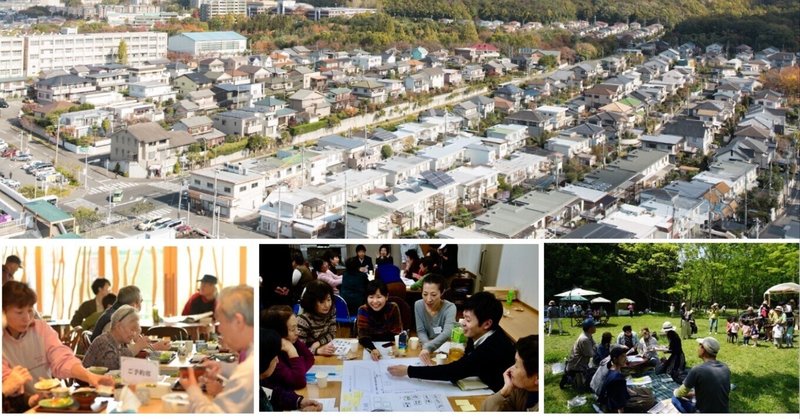
Third Places in Neighborhoods and Our Activities(draft)
0. A third place where weak ties are created
In aging communities, new shared spaces and services are being provided to foster community ties. Instead of using traditional development methods, welfare diversion efforts are underway that take into account welfare and community life. In this document of the international meeting of “Neighborhood Third Place”, we will introduce specific examples of welfare diversion projects we have been involved in and discuss their effectiveness, design, and management from the perspective of a "third place where weak ties are created.”
1. Rapidly growing number of vacant houses is an opportunity for welfare utilization
Super-aging residential areas present major problems: after more than 30 years, super-aging residential areas have emerged, causing a variety of problems such as aging homes, an increase in vacant houses and a decrease in the number of places to stay, living insecurity, an increase in refugees from shopping and those requiring nursing care, declining health and activity levels, and shrinking human interaction and connections. Although approximately 80% of residents feel attached to their communities and wish to continue living in their neighborhoods, 77%-98% of residents are concerned about the future in terms of convenience, community activities, public safety, aging population, aging population, vacant houses, and infrastructure. In the residential areas we surveyed, about 20% of the heads of households will change generations in 10 years, and about 60% in 20 years. This means that half of the housing units could become vacant in the next 20 years. In order to deal with this situation, we need a system that not only supports the elderly, but also revitalizes the community into a "community where people want to live" where the next generation can move in and where multiple generations can coexist1).
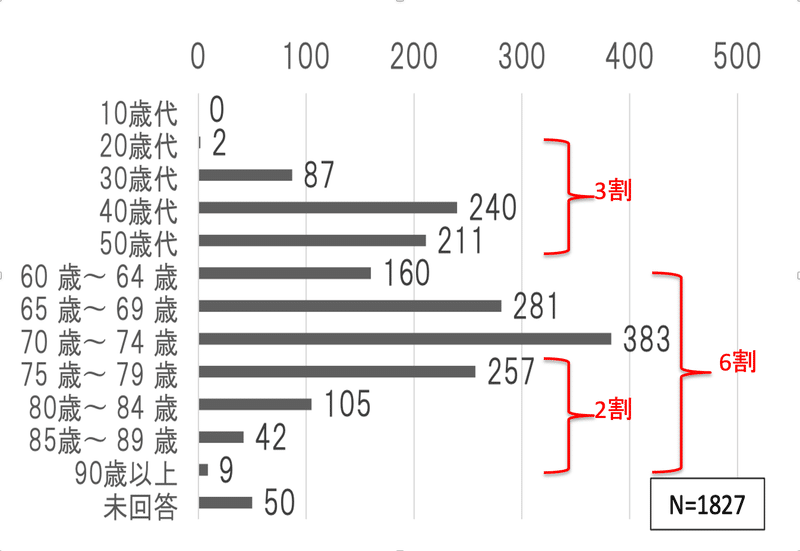
Welfare conversions and community projects based thereon are attracting attention. In line with the concept of a comprehensive community care system, the Japanese government has revised the legal system for the utilization of vacant houses and developed support measures such as long-term care insurance services and uninsured support, and resident-led welfare places such as "welfare convenience stores5)," "places to go6)," "children's cafeterias7)," and "community health centers8)" are expanding close to the community. These efforts are supporting the lives of residents and deepening community ties. It has become clear that a new approach to solving problems in super-aging communities is effective not only in improving facilities, but also in making the most of what is available in the community and connecting it to the future.
This trend has spread to China, Australia, and other countries that have rapidly developed residential areas, and is a common international issue. It is the result after half a century of a social phenomenon in which urbanization has led to the mass development of housing for families raising children in green suburbs within commuting distance.
2. Our practice began with a survey of good welfare environments
Twenty years ago, we conducted a survey of "good welfare environments" throughout Japan2). What we found was surprising. Rather than newly built welfare facilities, existing houses and stores were being utilized in a welfare way and becoming familiar to local residents. These were born naturally, and were created by the residents in a hands-on way to solve their daily life issues. They were born out of the utilization of local connections, transcending the boundaries of government. We called this "welfare conversion," and conducted a cross-sectional survey throughout Japan and in China, Australia, Finland, Sweden, and the United Kingdom3). What we found was that "welfare diversion" was a way to make the most of residents' attachments and respond to their detailed needs.
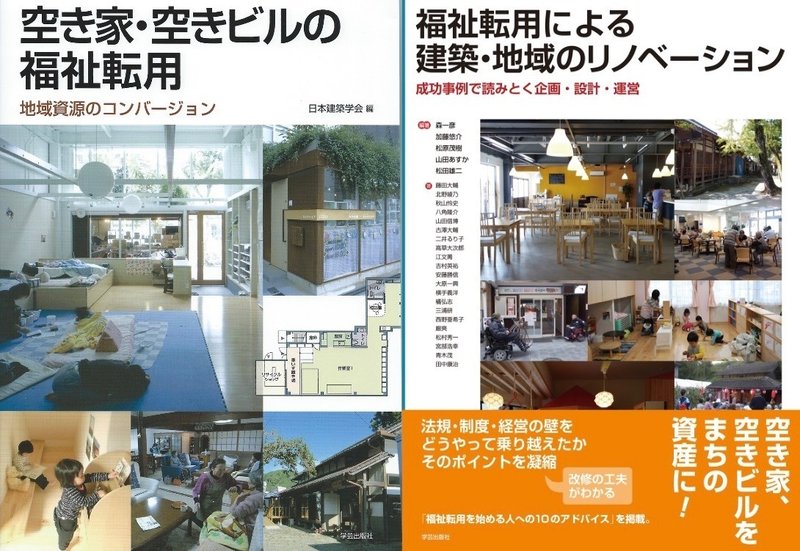
We have created a research network and are conducting detailed intervention studies in super-aging residential areas in metropolitan areas with populations in the millions, such as Kamakura in the Tokyo area, Nissin in Nagoya area, and Sakai in the Osaka area. These areas have aging populations, and efforts are underway to manage the areas and develop welfare centers through collaboration with universities and government agencies. For example, Sakai City's Makizukadai area (Osaka area), 50 years after its development, is a residential area within Senboku New Town, a hilly area 35 km from Osaka, characterized by a mixture of public housing and detached houses. The aging rate is over 30%, and the population has decreased from 7,000 to 5,000. Since 2009, a community council has been organized with the participation of Osaka Public University (formerly Osaka City University). The council is promoting the use of vacant rooms in public housing, vacant storefronts in neighborhood centers, and vacant houses for social welfare purposes such as senior citizen support housing, disability services, group homes for the disabled, and community restaurants4).

3. Well-being and Third Place
WHO defines wellbeing as "a state of being physically, mentally, and socially fulfilled, in addition to not being sick or infirm," and advocates a comprehensive perspective that goes beyond traditional medical health and well-being perspectives 9). While there are already methods for measuring health in a variety of areas, the perspective of linking them in a comprehensive manner highlights the critical importance of human connection and interaction for health and well-being.
In particular, the concept of "third places," with a focus on the elderly, is attracting attention. This can be defined as a shared place that is neither a first place (home) nor a second place (work/school) but can host informal gatherings . It supports the "weak ties" that exist between neighbors and acquaintances as opposed to the "strong ties" between family members and close friends10) (Granovetter, 1973). It functions as a place where people from all walks of life can interact, create awareness, and support each other. It has been suggested that such an environment promotes social engagement among the elderly and improves their health and well-being.
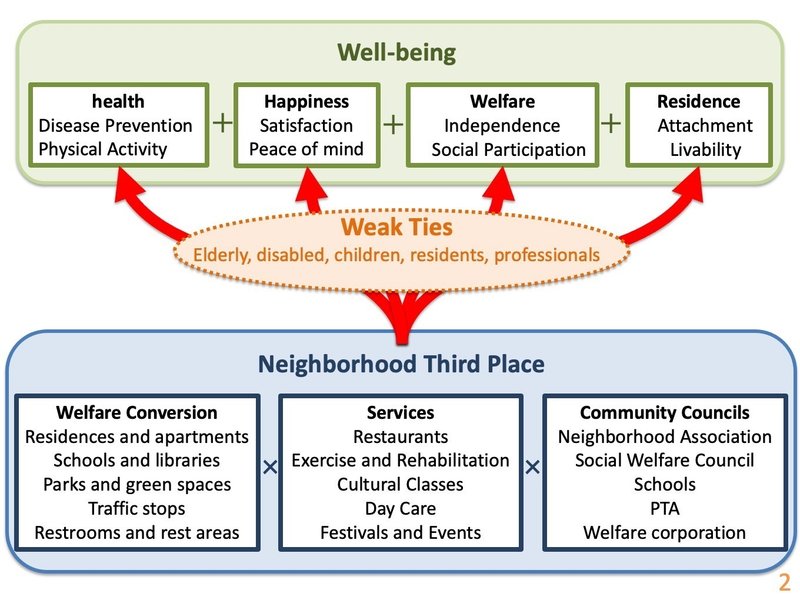
We conducted a paper review of Third Places for Older Adults' Social Engagement11). We found consistent evidence of the benefits of social engagement for the health of older adults and growing research interest in neighborhood third places where older adults are more likely to meet and socialize.
Third places are not only public places (libraries, public libraries, parks) and commercial establishments (cafes, bars, markets, beauty salons, barbershops, shopping malls), but also walkable neighborhoods are more important for seniors, people with disabilities, and children, with housing, schools, parks, and transit stops being the most important issues. The most important issues are housing, schools, parks, and bus stops.
4. Overlap services.
Neighborhood third places are difficult to develop from the top down and must be gradually aligned with local needs. To this end, it is essential to have a "community council" that manages the community through the cooperation of local neighborhood associations, schools and universities, welfare organizations, and stores. This is where vacant houses and spaces in the community must be utilized to develop various community services.
In addition to stores, schools, and parks in neighborhoods, some residences are being used as places to provide community services. A closer look reveals the following: (1) places to stay, (2) cafes/restaurants, (3) garden gardens, (4) hobbies/enjoyment, (5) working spaces, (6) studios/galleries, (7) exercise/care prevention, (8) barbering/beauty, (9) rehabilitation/massage, (10) outing support, (11) shops/convenience stores, (12) day service/short stay, (13) shared House, (14) care counseling/caregiver support, (15) watch over, (16) support for household chores, and various other services and combinations of services. These are superimposed on each other to develop the actual business.
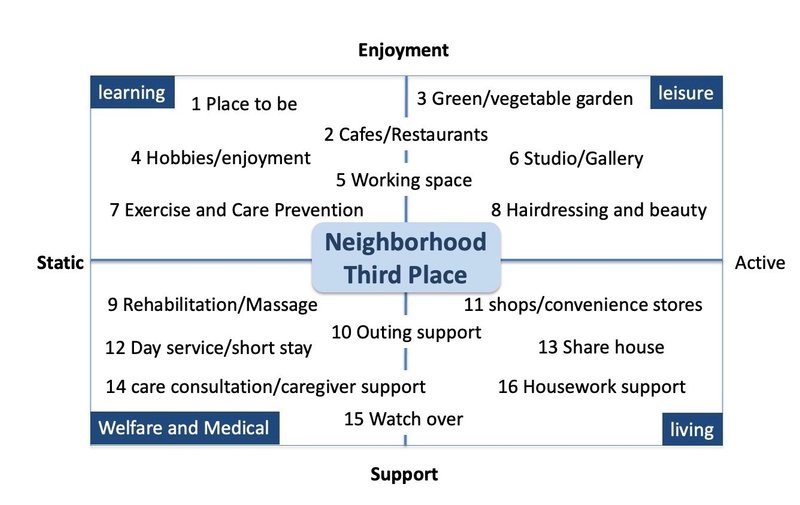
5. New Living Landscape in Residential Areas
Residential neighborhoods and towns developed after the war are in the process of brewing, and new activities and cultures are emerging as the next generation moves in. Christopher Alexander (1979) points out that society as a whole should have a shared yet individual uniqueness, and that guidelines are needed in rebuilding a balanced community12). Planning for this balance is essential to the development of a town where people with diverse life cycles are woven together.
We considers what is required to brew a town where the life cycles of diverse people - children, elderly, disabled, singles, visitors, mothers, children, families, and communities - are woven together. Neighborhood Third Places are within walking distance of life, provide freedom of activity, and also provide a mechanism for the economy to revolve within the community. It functions as a cared-common place where care givers and receivers are interchangeable. As a result, health and security are compatible, leading to a new landscape of living that we have not encountered before.
Citation of literature.
1) Kazuhiko Mori: Welfare Environment Design Original Theory - Brewing of Habitation, Public University Joint Press, 2022. (森一彦:福祉環境デザイン原論-居住のブリューイング、公立大学共同出版会、2022)
2) JIA (red.) (Kazuhiko Mori et al.): 'Welfare Conversion of Vacant Houses and Buildings - Conversion of Local Resources', Gakugei Shuppan, 201209. (日本建築学会編(森一彦ほか):「空き家・空きビルの福祉転用—地域資源のコンバージョン」、学芸出版、201209)
3) Kazuhiko Mori (red.): "Renovation of Buildings and Communities through Welfare Conversion", Gakugei Shuppan, 201803.(森一彦(編):「福祉転用による建築・地域のリノベーション」、学芸出版、201803)
4) Redaksjonskomiteen for Senboku Hottokunai Suburbs (Kazuhiko Mori et al.): Hottokunai Suburbs - Connecting New Towns to the Next Generation, Osaka Public University Press, 201710. (泉北ほっとかない郊外編集委員会(森一彦ほか):ほっとかない郊外-ニュータウンを次世代につなぐ、大阪公立大学出版会、201710)
5) Convenience stores of welfare(福祉のコンビニ)": https://www.pref.osaka.lg.jp/jiritsushien/kosaetann/konbini.html
6) " Places to go(通いの場)": http://kayoinoba.mhlw.go.jp/article/030/
7) " Children's cafeterias(子ども食堂)": https://musubie.org/en/
8) "Community health centre(まちの保健室)": http://www.osaka-kangokyokai.or.jp/CMS/00026.html
9) Constitution of WHO (the world health organization)
10) Mark S. Granovetter: The Strength of Weak Ties, American Journal of Sociology, Vol. 78, No. 6 (May, 1973), pp. 1360-1380 (21 pages)
11) Masaaki Sugiyama, Hing-Wah Chau, Takumi Abe, Yusuke Kato, Elmira Jamei, Piret Veeroja, Kazuhiko Mori, and Takemi Sugiyama : Third Places for Older Adults’ Social Engagement: A Scoping Review and Research Agenda, The Gerontologist cite as: Gerontologist, 2023, Vol. 63, No. 7, 1149–1161.
12) Christopher Alexander :Timeless Way of Building (Center for Environmental Structure), 1979/1/1(クリストファー・アレクザンダー:時を超えた建設の道, 1993/10/5)
この記事が気に入ったらサポートをしてみませんか?
